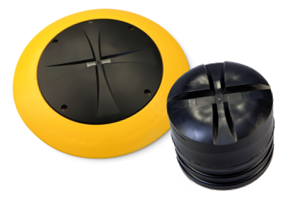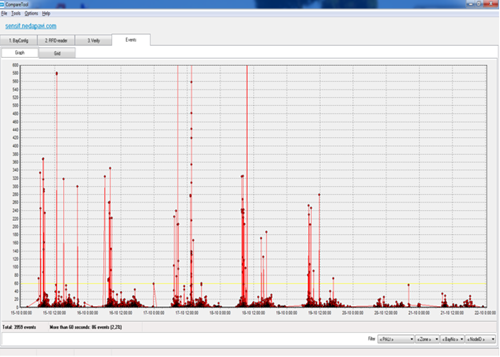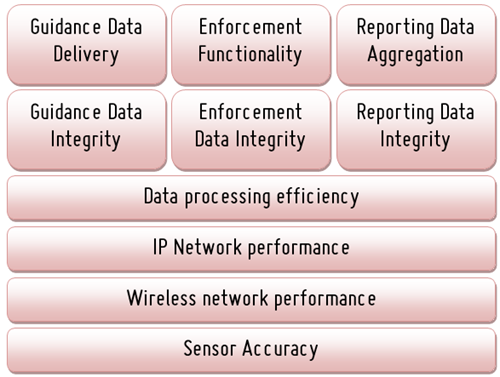Testing a wireless parking sensor network
How to define and measure the performance of a mesh network of vehicle detection sensors

The international market for smart sensor networks is developing rapidly. A lot of projects and pilots are currently carried out which involve wireless sensors that measure parking bay occupancy. Very often we are asked about the expected performance of these systems and ways of measuring that performance. The definition of performance however appears to be very ambiguous. Based on our experience in projects we would like to share some of our thoughts on this topic that might help you define performance criteria for your installation.
The big promise
The current popularity of M2M in general and wireless parking sensors specifically is very much related to the theme of smart cities and the related topics of smart mobility and traffic flow. Wireless networks of parking sensors potentially help motorists finding available on street parking bays easily and quickly, thus increasing the traffic flow and decreasing the likelihood of congestion and the unnecessary emissions that are related to that. It is also expected that the ability of these sensors to keep track of the time that the bay is occupied will also increase both the effectiveness and efficiency of parking enforcement.
The good news is that current installations already show proof of this potential. On street parking sites are in general utilized better and quicker when our SENSIT system has been installed and a guidance system, consisting of displays, apps or in car services, is put into use. Current projects also show proof that installing visible parking bay sensors actually increases the willingness to pay for parking bays. One installation in Italy for example, showed a monthly increase of parking revenue with a stunning 12 percent. And these sensors were not even activated yet!
There is definitely a business case for applying sensors in cities, airports and certain industrial estates. Increase traffic flow, reduced emissions, optimized parking capacity utilization and increased visitor satisfaction can be converted into financial return on investing in technology like this. That is, of course, if the technology is really able to live up to its promises. A lot of new entrants have, over the past few years, attempted to introduce wireless parking sensor technology to the market. And unfortunately some of these projects failed, which really has not added to the belief that these systems really can bring something good. We at Nedap feel that this is very regrettable and it is not doing the potential of wireless parking sensing justice.
Three questions
When investing in technology like this, it is important that you can actually trust the system to deliver the solutions and the benefits that you were looking for. Whether you would like to support systems for guidance, for enforcement or reporting, you would probably at least wonder about the following three questions:
- Is the parking occupancy information accurate?
- Is the parking occupancy information timely?
- Is the parking information provided consistently?
The first question is very obvious. When a sensor is meant to detect if a car is parked in that location, you would like to be sure that the device is able to accurately perform that job.
The second question is maybe less obvious. If a car is detected, this event should be known quickly enough. If you wish to send motorists to empty parking bays, it does not really help to let them know there was an empty bay somewhere two hours ago. So timeliness is important.

Wireless parking sensors
When you do invest in a parking detection system, you also want to be sure that the system is available at the moments that it matters. Especially when it is busy and there is a lot of traffic, motorists may appreciate some assistance. When there is not too much traffic going on and parking spaces are easily available, motorists probably care less. The architecture should be scalable and robust, making the system reliable and trustworthy, especially at times when parking guidance could make a difference.
These questions are self explanatory. But the next question would be how to measure the performance of the system and how to define your performance criteria.
Accuracy of information
The accuracy of a measurement is the degree of closeness of measurements of a quantity to that quantity's actual (true) value. Parking sensors are binary measurement systems. They will tell you if a car is there or not (and probably keep track of the time that a car is parked there).
Nedap’s standard SENSIT sensors use dual technology sensing (magnetic and IR) and we have proven that in average circumstances these sensors are able to achieve very high accuracy rates. In this case the accuracy rate refers to one sensor which is repeatedly checking for the presence of a car. The number of successful attempts divided by the number of total attempts will provide you with an accuracy percentage. This percentage very much depends on local circumstances. In ideal circumstances it might be close to a hundred percent. In difficult circumstances it might be less.
You could also look at a parking bay with, let’s say, 10 parking bays equipped with sensors. If you would do a repeated check on all those sensors and you would only call the experiment a success when all parking sensors provide accurate information, this would definitely result in lower accuracy percentages.
When measuring the accuracy of sensors, it is also important to keep in mind that most wireless mesh networks will show a delay of at least a few seconds before sensor generated events reach the server application that shows the sensor status. This might impact accuracy measurement results as well. Sophisticated sensor networks will however use time stamps in event messages, which makes the accuracy level of the sensors much more transparent: each status change is stored in a database and can be check against the real life status of parking bays at that exact time.
Timeliness of information
The speed of wireless networks of sensor nodes is something Nedap would advise you to have a serious look at when you consider implementing such a network. It might make sense to identify the potential and real speed of the network.
Nedap’s mesh network is self supporting and does not need external devices to run, it supports bidirectional communication, supports routing of events and supports remote updates of firmware in sensor nodes. The network protocol contains a mechanism against packet loss, which ensures data integrity. The network is usually reliable and fast. The vast majority of parking events are known throughout the system in a matter of seconds.
Less than optimal network speed is considered latency. In reality there are numerous causes for low or high levels of latency. Project experience has taught us that is important to be able to deeply analyze the network performance to be able to find sources of unnecessary latency. The larger the project, the greater the chance of finding sources of latency. A few examples of potential sources of latency are:
- Unlawful radio emissions from third party sources.
- IP network infrastructure errors.
- Installation or configuration errors.
- Sabotage by third parties.
To analyze the network performance we have developed a few tools and instruments. One example is the so called ‘Compare Tool’. A screen dump is shown underneath:

The tool compares the timestamp of the sensor generated message with the timestamp of when the event was stored in the database. This example shows that a lot of events have reached the server in a few seconds. Some events seem to be travelling a long time. The tool supports zooming into those events and isolating the incidents, which makes it possible to see if specific zones or specific sensors are affected.
When considering systems like these it makes sense to look at your application and define the time you would allow a parking event (status change) be known throughout your system. For parking guidance and payment enforcement applications it obviously seems important to have a real-time view on the status of bays. For reporting applications or zone based guidance systems a little delay might not be a problem.
Consistency of information
The system you are thinking of deploying should be resilient and robust. It should be able to perform well day and night, during peak hours and in more quiet times, in sunny conditions and in situations with rain and snow. The accuracy levels and latency levels should also be as consistent and possible in sometimes difficult situations.
The robustness and also the agility of the system really has to do with the architectural setup of the system and the quality of all components.
Nedap sensors come in different shapes for different applications and environments. All devices are thoroughly tested and only durable high quality materials are used. The network protocol is optimized not only for low power consumption, but also for robustness. The server software architecture of optimized for scalability.
No weak links
It is important to realize that defining or measuring the accuracy or speed of wireless mesh network of parking sensor nodes requires more effort than just looking at the theoretical accuracy of one individual sensor. Whether the end-user or administrator of the system will be presented with accurate and timely information very much depends on the quality of each module or device in the entire architecture:

The figure above is showing a generic model for parking sensor systems, which illustrates the different steps in processing information in such a system. Let’s have a look at it bottom up and provide you with an example: A sensor detects a car en generates a message, this message is sent over the wireless network to an IP gateway, the IP network transports the message to an application with a database, the application processes the message and forwards a status change to an enforcement, reporting or guidance system. The information is then formatted and then presented to the user in an app, on a display or through a web browser.
The accuracy and performance of the system very much depends on the quality of execution in each and every step of the process mentioned above. And the quality of each step relies on the quality of hardware and software used, but also on the quality of services related to installing, configuring and using that piece of hardware of software.
The basic concept of wireless parking sensors is simple and straightforward. Implementing a successful system for guidance or enforcement based on that concept is however a little more complicated and requires careful preparation and planning.
The process of defining performance criteria and measuring the performance of the parking detection against those involves identifying critical components and services in the architecture. It requires an understanding of that architecture and the ability to measure performance at the right level in the right way.
Please speak to your Nedap representative to find out more.
About Nedap AVI
For almost twenty years the Dutch technology company Nedap AVI has been considered an expert in advanced and effective solutions for automatic vehicle identification and wireless vehicle detection. SENSIT detects vehicle occupancy at every single parking space. Real-time parking information can be used to guide traffic effectively, to improve the utilization of parking capacity and to manage parking enforcement more efficiently. During the Intertraffic fair in 2006, SENSIT was awarded as the most innovative solution in parking. Since that day, Nedap has been focusing on designing the most accurate sensor hardware and the most reliable communication network using wireless sensor nodes. Nedap has designed the solution to be easily integrated with third party systems for parking guidance and traffic management systems, way finding apps and enforcement equipment used by major cities all over the world. www.nedapavi.com.


Comments
There are no comments yet for this item
Join the discussion